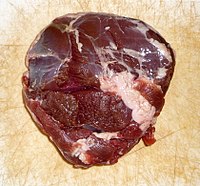
Photo from wikipedia
Despite wild food plants' potential nutritional and economic value, their knowledge and consumption is quickly decreasing throughout the world. We examine how the consideration that a wild plant use is… Click to show full abstract
Despite wild food plants' potential nutritional and economic value, their knowledge and consumption is quickly decreasing throughout the world. We examine how the consideration that a wild plant use is within the cultural tradition of a given area relates to its consumption by analysing 1) current perception and 2) past and present use of six wild plants' food-uses, of which only three are locally perceived as being part of the local tradition. Research was conducted in Gorbeialdea, an area in the Basque Country with a clearly marked Basque identity opposed to the Spanish identity. Overall, there is a clear decrease in the knowledge and consumption of the selected uses and especially of the three uses acquired from local sources (i.e., the consumption of the raw leaves of Fagus sylvatica and Rumex acetosa and of the fruits of Pyrus cordata). The trend is likely driven by the disappearance of the traditional agrarian lifestyle. Among the uses not acquired from local sources, the use recently adopted from another Basque-speaking area (i.e., macerating the fruits of Prunus spinosa to elaborate a liqueur) is now considered part of the local tradition by young generations, whereas the use acquired from southern Spanish migrants (i.e., using Laurus nobilis leaves as condiments) is not. While lifestyle changes largely explain overall trends in wild edibles consumption, other cultural aspects -in our case study the stigmatization of a given source of information associated to cultural identity- might help shape which new uses of wild plants become embedded in local traditions.
Journal Title: Appetite
Year Published: 2017
Link to full text (if available)
Share on Social Media: Sign Up to like & get
recommendations!